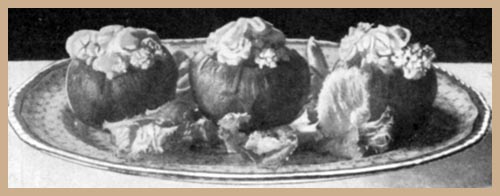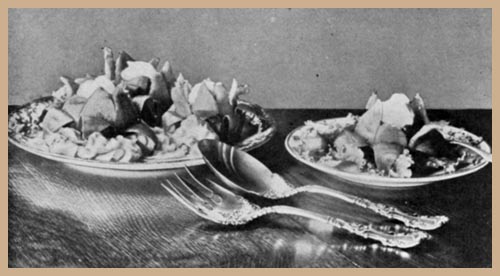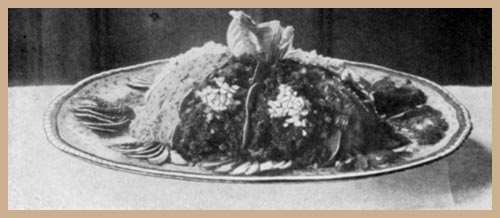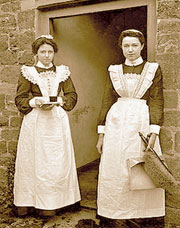Here is an article about my ancestor, the Earls of Orkney, and his trip to Kiev, capital of ancient Russ when it ws ruled by Vikings
Preparing and Dressing Salad Plants
Outside of the commonest duties of her profession there is no one subject on which a waitress needs to perfect herself with more care than that which relates to the cleansing and care of salad plants, the making of saiad dressing, and the dressing of salads. The mixing of a mayonnaise dressing is a mechanical operation, and should be mastered at the first trial. A perfect emulsion of oil and acid is to be secured by means of egg yolks. The old way of mixing the ingredients with the eggs the addition of the oil to the egg, drop by drop, was tedious, and without great care it often resulted in failure. By the new method, given in this chapter, success is assured, and the process is materially shortened. Formerly no acid was used until considerable oil, added drop by drop, had been beaten into the condiments and egg yolks; by the new method all the acid to be used is first stirred into the well-beaten yolks and condiments ; then into this larger quantity of material the oil may be added by the teaspoonful, and later on by the tablespoonful. A Dover egg-beater of small size (tumbler beater) is used at first, but after a little while the beater of ordinary size works to better advantage.
CRISPNESS AND CLEANLINESS FIRST ESSENTIALS
Plants eaten uncooked, as celery, endive, and lettuce, are not easily penetrated by the digestive fluids unless they be fresh and crisp. A wilted salad plant is most unwholesome. Vigorous and healthy plants are often infested with tiny insects of the same color as the plant itself, and only the most exact and painstaking care will remove them from the tender leaves. A hasty plunge in cold water is not enough. Each several leaf needs careful attention and examination. If salad plants cannot be made crisp, or if doubt as to their absolute cleanliness exists, discard them. Lettuce and celery may be freshened by setting them in ice-water.
CLEANSING AND PREPARATION OF LETTUCE, TOMATOES, CELERY, ETC.
Lettuce
- Cut off the root and coarse or ragged outer leaves.
- Wash each leaf singly by rinsing up and down in cold water, changing the water often.
- Let the leaves, if wilted, stand in cold water to freshen.
- Shake them in a wire basket, a colander, or a cheese-cloth bag.
- Set them aside in a cold place until nearly time to serve.
- Wipe each leaf, without bruising or crushing, with a soft cloth.
- Mix with dressing and send at once to the table.
Peel tomatoes, cut out the hard centres round the stems, and set them near the ice, to become chilled.
 Above: Celery Club House Style
Above: Celery Club House Style
Cleansing and Preparation of Celery
The best celery heads are not fastened together with nails, but are tied with straw. This leaves the roots in good condition for serving.
The roots are tender, and, though close-grained, are free from coarse fibres. When dressed " clubhouse fashion," the root is retained. To dress celery in this style, remove the coarse outer stalks, cut off the ends of such remaining stalks as are mostly fibrous down to the more solid portion, and trim the root neatly, discarding the outside discolored by exposure to the air. Cut through the centre of the head and the root If the halves are large, cut each in the centre, thus dividing the whole head into quarters. Wash in plenty of cold water, holding lengthwise under the faucet when convenient. Crisp in the same manner as lettuce, drain, and wipe dry. When the root is not served, cut it off close to the stalks, separate the stalks carefully, wash, crisp, and dry as before. When salad plants are brought from the market, keep from the air in a closed vessel or tightly wrapped in paper. To avoid a rusty appearance, especially in the case of celery, postpone the use of water until a short time before serving. Though celery served as an appetizer or in salads be carefully trimmed, the remnants should not be regarded as waste, All sound leaves and stalks are a valuable acquisition to the larder.
PREPARATION OF COOKED MEAT, VEGETABLES, ETC.
- Cut cooked meat, freed from fat and gristle, and vegetables into pieces of uniform size and shape.
- Season with French dressing and set aside to become " marinated " and chilled.
- Drain (to avoid liquifying the mayonnaise) and mix with mayonnaise dressing, then dispose on a bed of green vegetables or otherwise.
Salads are very good or very bad. There is no half-way ground in this matter. It is impossible to set down the exact proportions and quantities of oil, acid, and condiments needed to dress any salad, nor is it possible to prescribe an exact method of mixing the various ingredients. A "pianissimo touch" of onion is a grateful addition to most salads, and is a positive necessity in some salads, as those made of cooked beans and potatoes.
Cold potatoes swimming in oil are far from palatable or hygienic, and such a combination can lay no claim to the name of salad. Potatoes, without flavor themselves, can be made into a good salad, because they can be made a medium of carrying other flavors. Onion is as necessary to a successful potato salad as is oil and acid, nor must salt be lacking. Potatoes have an affinity for salt and onion, and oil also, judging by the quantity they can be made to take up. Coarse pieces of crude, uncooked onion or cruder garlic will not do. For a small quantity of salad, rubbing over the bowl with the crushed half of a clove of garlic will give flavor enough to inoculate the whole. A slight grating of mild Spanish onion or a tablespoonful or two of fine-chopped chives will also prove quite sufficient. But think not to make a satisfactory potato salad without calling into requisition some member of this useful family.
We speak of "tossing up" a salad. This would seem to indicate that a salad is put together quickly; but there are salads and salads, and the time to be expended on the mixing of them must be gauged by the knowledge of the salad maker. If she have not a mental picture, and palate picture as well, of what the finished product should be, the salad cannot fail to be other than disappointing. Of course, one may have moments of inspiration, when the understanding is so quickened that a salad of unsurpassed merit is evolved. Still, every-day, prosaic people cannot trust to inspiration, but need to consider and weigh with care the composition and qualities of the articles to be dressed. Potato needs to be turned over and over again in the dressing, until one's stock of patience is well-nigh exhausted. Then, and not till then, may it be set aside to become thoroughly impregnated with the seasonings and oil, "to ripen," as it were.
Not after the same fashion can we treat the ingredients of a celery and apple salad. By long standing in the dressing the celery wilts, which, to be at its best, must not have parted with its pristine crispness. Nor will it take up a tithe of the dressing prepared for an equal bulk of potato; yet it needs to be dressed "fatigued," the French say with care and discrimination. A judicious pressure must be brought to bear upon its unabsorbent texture, to force it to take up a modicum of those elements whiclrit lacks, to make a complete dish. Often the more clinging nature of the sauce mayonnaise commends it to favor, when celery is to be dressed for other than a dinner salad.
FRENCH DRESSING
General Formula
1/2 a teaspoonful of salt
1/2 a teaspoonful or less of pepper
6 tablespoonfuls of oil
2 to 6 tablespoonfuls of vinegar
Mix the salt and pepper with the oil; beat in the vinegar graduall, beating until an emulsion is formed.Then pour the dressing over the prepared materials, and turn them over and over until the dressing has been evenly mixed throughout.No dressing should remain in the bottom of the bowl, but the leaves or other articles dressed should be glossy with oil.If they look dry, mix more dressing, and add in the same manner as before.The quantity of acid used depends upon the article dressed and the dish with wich it is to be be served.More acid would be indicated is the salad is to be served with a rich oily roast, as pork or turkey, than with game, wich is proverbially dry and lean.Three or four half-inch squares of bread may be placed in the bottom of the salad bowl to absorb any surplus dressing.
MAYONNAISE DRESSING
A few grains of cayenne or paprika.
1/2 a teaspoonful of salt.
The yolks of two raw eggs.
1 pint of olive oil.
2 tablespoonfuls of lemon juice.
2 tablespoonfuls of vinegar.
1 teaspoonful of powdered sugar and 1/2 a teaspoonful of mustard if desired.
Mix the salt and paprika, and add the yolks of egg, wich sould be fresh; beat until the yolks are well thickened, then gradually beat in the lemon juice and vinegar.Put a Dover eggbeater into the mixture and beat in the oil a teaspoonful at a time; beat throughly between each addition of oil.Add more seasoning if needed, cover with an earthen dish, and let stand in a cool place until time of serving.If sugar or mustard, one or both, be desired, add to the salt and pepper.For other recipes pf salad dressings, see "Practical Cooking and Serving" and "Salads, Sandwiches, and Chafing-Dish Dainties" by the author.
SERVING OF SALADS
To determine the place of a salad in a meal, note its nature and why it is served. Fish served with rich sauces needs a mild acid and a dilutant, to tone down the richness. The same is true with the roast and game. Then a crisp, succulent vegetable with the simple French dressing would render the fish and meat course complete, and a rich heavy salad would be quite out of place.
For aesthetic reasons cucumbers or tomatoes, preferably cucumbers, are the choice with fish, while cress, celery, endive, escarole, chicory, or one of the varieties of lettuce, or celery, or cress, with apple, orange, or pineapple, is to be preferred with the roast or game. A mayonnaise of cauliflower, tomatoes, or asparagus is often served as an entree or a course by itself, A cucumber salad with the fish course does not preclude the serving of a second salad; but after serving a salad with game no salad, as a fruit salad, should thereafter appear in the menu. Celery with mayonnaise dressing accompanies wild duck and birds with dark flesh. Lettuce, or lettuce and tomatoes with French dressing, are preferred with quail, broiled chicken, or game with light meat; while cabbage with mayonnaise dressing to which whipped cream has been added is the choice when oysters are served.
THREE NOVEL SALADS
 Above: Tomato Salad, Du Barry Style
Above: Tomato Salad, Du Barry Style
Tomato Salad, Du Barry Style
Peel a tomato for each person to be served. Cut out a piece around the stem of each, and scoop out a portion of the pulp. Sprinkle inside with salt, and set upside down in the refrigerator. When ready to serve, fill the open spaces with cold, cooked cauliflower and set on heart leaves of lettuce. Put a spoonful of mayonnaise on each, and serve at once.
 Above: Tomato Salad Poinsettia Style
Above: Tomato Salad Poinsettia Style
Tomato Salad, Poinsettia Style
Select round, smooth tomatoes. Take one in the hand, keeping the stem end down. A close examination will show light lines running underneath the skin from the centre outwards. These separate the tomato into sections, each of which contains seeds. Cut through the skin along these lines from the centre to about an inch from the stem end, then cut through the pulp underneath to the depth of one fourth an inch. With a sharp-pointed French knife peel each section of skin from the pulp below, then lift the pulp in triangular sections about one fourth an inch thick. These, if cut properly, will be of the same shape and size as the sections of skin, and each will form a circle resembling the petals of a flower. Let chill thoroughly in the refrigerator. Then, when ready to serve, cut out the hard centre at the stem end without injury to the shape of the flower. Season with salt and pepper; fill the open space beneath with mayonnaise, and set the tomato on an individual plate. Put heart leaves of lettuce around the outer row of petals, bending them over the lettuce. Turn back the second row of petals, and fill the centre with mayonnaise. Serve as a salad course at luncheon or dinner.
 Above: Potato Salad
Above: Potato Salad
Potato Salad
Chop very fine half a small, young, and mild onion and half a green pepper-pod. These should be as fine as if they had been grated. Cut six cold, boiled potatoes into small cubes of the same size (less than half an inch in diameter). Mix the potato, pepper, and onion with five or six tablespoonfuls of oil. Mix very thoroughly, turning the potato over and over and adding more oil, if needed, to make each piece of potato glisten with oil. Shake in a teaspoonful of salt and a dash or two of paprika, while mixing in the oil. Then add three or four tablespoonfuls of vinegar, one tablespoonful at a time, mixing in each before the next is added. Rub the salad bowl with the cut side of a clove of garlic. Put in the salad, shaping it into a firm mound. Set this aside in the refrigerator for an hour or longer. Then cover or mask with mayonnaise dressing. With capers or sliced olives divide the mound into six sections. Fill in these with sifted yolks (cooked), chopped whites of eggs, and chopped beets. Decorate the sections in contrasting colors. Set a tuft of lettuce hearts in the top, and garnish the edge with tiny gherkins, cut in very thin slices nearly to the stem end, and spread to represent fans.




